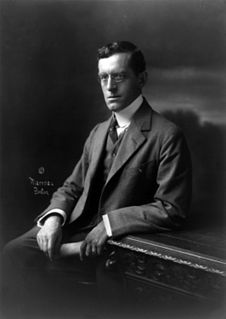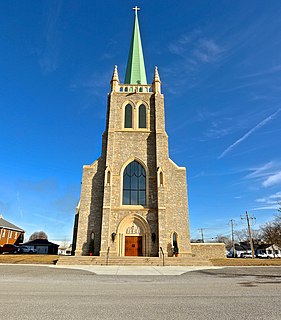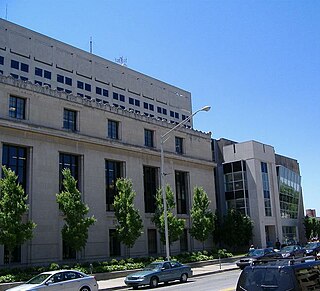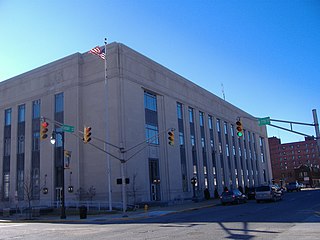
Ralph Adams Cram was a prolific and influential American architect of collegiate and ecclesiastical buildings, often in the Gothic Revival style. Cram & Ferguson and Cram, Goodhue & Ferguson are partnerships in which he worked. Together with the architect Richard Upjohn and artist John LaFarge, he is honored on December 16 as a feast day in the Episcopal Church of the United States. Cram was a fellow of the American Institute of Architects.
Charles Willard Moore was an American architect, educator, writer, Fellow of the American Institute of Architects, and winner of the AIA Gold Medal in 1991. He is often labeled as the father of postmodernism. His work as an educator was important to a generation of American architects who read his books or studied with him at one of the several universities where he taught.
Zantzinger, Borie and Medary was an American architecture firm that operated from 1905 to 1950 in Philadelphia. It specialized in institutional and civic projects. For most of its existence, the partners were Clarence C. Zantzinger, Charles Louis Borie Jr. and Milton Bennett Medary, all Philadelphians.

Cram and Ferguson Architects, original partnership was founded in 1889 by the "preeminent American Ecclesiastical Gothicist" Ralph Adams Cram and Charles Francis Wentworth. In 1890 they were joined by Bertram Goodhue, who was made a partner in 1895.
Tachau and Vought was an American architectural firm active in the mid-twentieth-century New York City that specialized in mental hygiene hospitals. It was established in 1919 as the successor to the architectural firm of Pilcher and Tachau by William G. Tachau and Vought. By 1946, Vought had left. Eliot Butler Willauer was a principal from around 1945 until 1946. The firm moved from 109 Lexington Avenue to 102 East 30th Street around 1923.
William Gabriel Tachau, AIA,, was an American architect active in early- to mid-twentieth-century New York City. With Lewis Pitcher, he was a partner in the architectural firm of Pitcher & Tachau from 1904 to 1919 when he established the firm of Tachau & Vought. Both firms from 1918 onward specialized in mental hygiene hospitals. The firm moved from 109 Lexington Avenue to 102 East 30th Street around 1923 and remained at that address and that name even after Vought left.
Eliot Butler Willauer, AIA, was an American architect active in mid-twentieth-century New York City. With William G. Tachau, he was a principal in the architectural firm of Tachau & Vought, the successor firm to Pitcher & Tachau. The firm, located on 102 East 30th Street around 1923, specialized in mental hygiene hospitals. He went on to a career as an associate with the firm of Eggers & Higgins.
Kurt Vonnegut Sr. was an American architect and architectural lecturer active in early- to mid-twentieth-century Indianapolis, Indiana. A member of the American Institute of Architects, he was partner in the firms of Vonnegut & Bohn, Vonnegut, Bohn & Mueller, and Vonnegut, Wright, and Yeager. He designed several churches, banks, and became the in-house architect for Indiana Bell and Hooks Drug stores, practicing extensively in the Art Deco style. He was the father of chemist Bernard Vonnegut and author Kurt Vonnegut Jr.

Pierre and Wright was an architectural firm in Indianapolis, Indiana in the United States. It was established in 1925 by partners Edward D. Pierre, AIA (1890–1971) and George Caleb Wright, AIA, (1889–1973). It was one of the predecessor firms of Vonnegut, Wright & Yeager.

Miller & Yeager was an architectural firm in Terre Haute, Indiana in the United States. It was founded in 1925 by Ewing Miller and Ralph Oscar Yeager, AIA,. It was one of the predecessor firms of Vonnegut, Wright & Yeager.

Anthony J. DePace (1892–1977) was an American architect who designed numerous Roman Catholic churches throughout the Northeastern United States area during the mid to late 20th century.
Robert J. Reiley, AIA, (1878–1961) was an American architect practicing in New York City in the early and mid twentieth century. He was particularly known as a designer of Catholic churches, schools, and hospitals in the Northeast USA.

Gustave E. Steinback (1878–1959) was an American architect practicing in New York City in the early and mid twentieth century. He was particularly known as a designer of Roman Catholic schools and churches. His offices were located at 157 West 74th Street in the 1920s, and in Stamford, Connecticut in the 1940s.
Lewis Greenleaf Adams, AIA, (1897–1977), was an American architect based in New York City who practiced in mid- to late-twentieth-century New York, New Jersey, and Connecticut, as part of the firms Malmfeldt, Adams & Prentice, Adams & Prentice, Malmfeldt, Adams & Woodbridge, Adams & Woodbridge, and under his own name at the end of his life, always based in New York City.
Frederick James Woodbridge, AIA,, was an American architect. His projects were based in New York, New Jersey, and Connecticut. He was partners in the firms Evans, Moore & Woodbridge, Malmfeldt, Adams & Woodbridge, and Adams & Woodbridge (1945–1974), as well as being a sometime archeologist.
Adams and Woodbridge was an American architectural firm in the mid-twentieth-century New York City, established in 1945 by Lewis Greenleaf Adams, AIA, and Frederick James Woodbridge, FAIA, and disestablished in 1974 after the latter's death. It was the successor to the firms Evans, Moore & Woodbridge, Malmfeldt, Adams & Prentice, Adams & Prentice, and Malmfeldt, Adams & Woodbridge
Adams & Prentice, Malmfeldt, Adams & Prentice, and Malmfeldt, Adams & Woodbridge were a series of American architectural firms in mid-twentieth-century New York City, with Adams & Prentice being the most well-known, all established by architect Lewis Greenleaf Adams, AIA with various partners. The series of partnerships were the predecessor firms of the influential firm Adams & Woodbridge, which was functional from 1945 to 1974 with partners Adams and Frederick James Woodbridge, FAIA, formerly of the firm Evans, Moore & Woodbridge. Adams & Woodbridge later estimated in 1953 that their firm and its above-mentioned predecessor firms had been responsible for “about 100 residences and alterations.” In 1929, the office was located at 15 West 38th Street, Manhattan.

Mellor, Meigs & Howe (1916–28) was a Philadelphia architectural firm best remembered for its Neo-Norman residential designs.
Robert Louis Geddes, is an American architect, planner, writer, educator, former principal of the firm Geddes Brecher Qualls Cunningham (GBQC), and dean emeritus of the Princeton University School of Architecture (1965-1982). As principal of GBQC, select major projects include Pender Labs at the Moore School of Electrical Engineering, University of Pennsylvania, the Philadelphia Police Headquarters, the Liberty State Park master plan, the Philadelphia Center City master plan, and his best-known work, the Dining Commons, Birch Garden, and Academic Building at the Institute for Advanced Study. He is a Fellow of the American Institute of Architects; recipient of honorary doctorates from Princeton University, City College of New York, and the New Jersey School of Architecture/NJIT; recipient of the Topaz Award from the American Institute of Architects and the Association of Collegiate Schools of Architecture, and, along with his firm, is the recipient of the Architecture Firm Award.

Ferruccio Vitale (1875-1933) was a landscape architect. Born in Italy, he became a United States citizen in 1921. The historian Terry R. Schnadelbach considered him to be "America's forgotten landscape architect."







